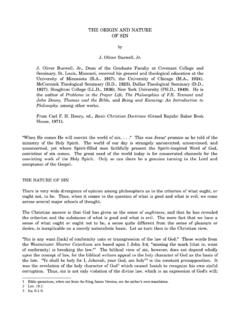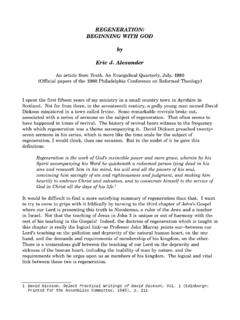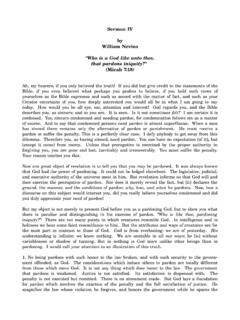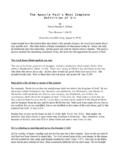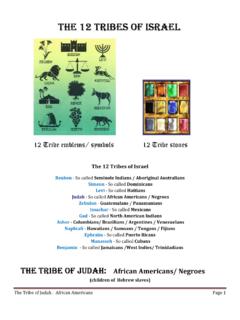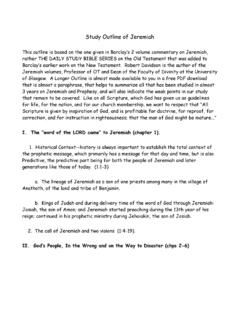Transcription of A BRIEF HISTORY OF THE KINGS OF ISRAEL AND JUDAH
1 A BRIEF HISTORY of the KINGS of ISRAEL and JUDAH by Ken and Carol Morgan January 2003. INTRODUCTION. The purpose of this paper is two-fold: first, to give in the main text a flowing narrative of the HISTORY of ISRAEL and JUDAH from the division of the kingdom to the fall of Jerusalem and, second, to discuss in the footnotes various technical, exegetical, chronological, and archeological problems associated with this period of HISTORY . There are also six appendices on subjects too long and involved for footnotes. ABBREVIATION USED IN THE FOOTNOTES. ANEP: Pritchard, James B. The Ancient Near East in Pictures. Princeton: Princeton University Press, 1969. ANET: Pritchard, James B. Ancient Near Eastern Texts. Princeton: Princeton University Press, 1969.
2 Chronology: Thiele, Edwin R. A Chronology of the Hebrew KINGS . Grand Rapids: Zondervan Publishing House, 1977. ISBE: The International Standard Bible Encyclopedia. Revised. Grand Rapids: William B. Eerdmans Publishing Co., 1988. Four volumes. MNHK: Thiele, Edwin R. The Mysterious Numbers of the Hebrew KINGS . New revised edition. Grand Rapids: Zondervan Publishing House, 1983. Reprinted by Kregel Publications, 1994. SIH: Wood, A Survey of ISRAEL 's HISTORY . Grand Rapids: Zondervan Publishing House, 1970. 1. THE DIVISION OF THE KINGDOM. Following the death of Saul in 1010 , David is anointed king in Hebron by the men of JUDAH . In response, Abner, commander of Saul's army, takes Saul's son Ishbosheth to Mahanaim and makes him king over all ISRAEL .
3 1 Ishbosheth reigns over ISRAEL for 2 years from Mahanaim, while David reigns over JUDAH for 7 years from Hebron. Near the end of the 2 years of Ishbosheth's reign, however, Abner turns his allegiance to David. But Joab, the commander of David's army, murders Abner. This was out of personal revenge over the death of his brother, Asahel, whom Abner had slain. 2 When Ishbosheth hears of Abner's death, he and all ISRAEL lose heart. Two brothers named Rechab and Baanah, sons of Rimmon of the tribe of Benjamin, conspire against Ishbosheth. These men are captains in the army of ISRAEL . They come to Mahanaim during the middle of the day while Ishbosheth is resting and assassinate him in his bedchamber. They bring his head to David in hopes of receiving a reward.
4 But David condemns this act of treachery and has them put to death for the murder of a righteous man. David instructs that the hands and feet of both men be cut off and their bodies hung by the pool at Hebron. In so doing David not only acts in accordance with the law, but also proves to the people that he had neither commanded nor approved of such a crime. David now reigns over all ISRAEL and JUDAH and moves his capital to Jerusalem. He rules from Jerusalem for 33 years, making his total reign 40 years. 3. When David's death becomes imminent, Adonijah 4 proclaims himself king . He is one of David's sons whose mother's name is Haggith. Adonijah does this without any authority from David and without his knowledge.
5 Since David had previously promised Bathsheba that their son Solomon would succeed him on the throne, and since Solomon was also God's choice, Nathan the prophet alerts Bathsheba. They both come before David and tell him what Adonijah has done. David then reaffirms his earlier promise made to Bathsheba and orders that Solomon be anointed king over ISRAEL and JUDAH . David dies in 970 His son Solomon also reigns for 40 years until 930 1. 2 Sam. 2:9. "All ISRAEL " means the northern tribes, all the tribes except JUDAH (v. 10). Evidence of division among the tribes is already apparent in 1 Sam. 11:8. The ultimate political separation into two kingdoms occurred after Solomon's death (1 Kgs. 12:16-17). 2. See 2 Sam.
6 2:12-23; 3:26-30. There was a battle between Ishbosheth's forces under Abner and David's forces under Joab. Abner is defeated, but Asahel, Joab's brother, does not let Abner retreat buts chases him until Abner is forced to turn and kill him. When Abner later tries to support David as king , Joab deceitfully lures an unsuspecting Abner aside and kills him. "This wanton act by David's leader was committed in retaliation for the death of Asahel; though one wonders how much Joab's fear of a rival for his position may also have contributed. David, desiring to court favor with the northern tribes, now did all he could to dissociate himself from the deed, showing true sorrow that it had happened (II Sam. 3:28-39)". (Leon Wood, SIH, p.)
7 263). 3. 2 Sam. 5:5. 4. David had evidently spoiled this son: "His father [David] had never crossed him at any time by asking, 'Why have you done so?'" (1 Kgs. 1:6). 2. Solomon begins to build the temple in 966, 480 years after the exodus. ISRAEL enjoys peace during Solomon's reign, as David had secured this peace for the kingdom by his many wars. God grants Solomon wisdom, glory, and riches. 5 During the course of his lifetime, Solomon takes 700 wives and 300 His goal in many of these marriages very likely was to establish diplomatic ties with the hundreds of city-states and kingdoms around This political strategy was itself sinful8, but it led to an even greater sin. Each of these "political" wives, "as a representative of her father's kingdom, brought with her the religious paraphernalia and the priests of her god.
8 " 9 Shrines and altars to pagan gods, complete with priests and overseeing queens, literally dotted the hills surrounding According to the biblical account, Solomon himself took part in the worship of these pagan gods: "For Solomon went after Ashtoreth the goddess of the Sidonians and after Milcom the detestable idol of the Ammonites. And Solomon did what was evil in the sight of Yahweh, and did not follow Yahweh fully, as David his father had done. Then Solomon built a high place11 for Chemosh the detestable idol of Moab, on the mountain which is east of Jerusalem, and for Molech the detestable idol of the sons of Ammon. Thus also he did for all his foreign wives, who burned incense and sacrificed to their gods.
9 " 12. 5. 1 Kgs. 3:5-13. 6. 1 Kgs. 11:3. 7. This strategy is explicitly stated concerning Pharaoh's daughter, Solomon's first foreign wife early in his reign (1 Kgs. 3:1). 8. See 1 Kgs. 11:1-2. Subsequent HISTORY also indicates that God is generally not pleased when his KINGS run to pagan KINGS for help (cf. 2 Chron. 16:7; 28:16-22; Hos. 7:11-12; 8:8-10). However, perhaps the alliance with Egypt through the marriage of Pharaoh's daughter was not an example of this sin. Solomon was not calling on Egypt for help, and only marriage to Canaanite women and treaties with Canaanite nations were expressly forbidden in the law (cf. Exod. 23:31-33; 34:12-16; Deut. 7:2). 9. John C. Whitcomb, Solomon to the Exile (Grand Rapids: Baker Book House, 1971), p.
10 18. This statement is true in general. However, C. F. Keil, "The Books of the KINGS ," Commentary on the Old Testament, pp. 38-39, argues that Pharaoh's daughter was an exception and that she became a worshipper of Yahweh. "Solomon adhered so faithfully to the Lord during the first years of his reign, that he would not have tolerated any idolatry in his neighborhood, and we cannot find any trace of Egyptian idolatry in ISRAEL in the time of Solomon, and, lastly, the daughter of Pharaoh is expressly distinguished in ch. from the foreign wives who tempted Solomon to idolatry in his old age.". 10. To get a mental image of what this must have been like, consider this description by Whitcomb: "Let us attempt to picture the situation that began to develop around Jerusalem during the last fifteen or twenty years of Solomon's reign.
